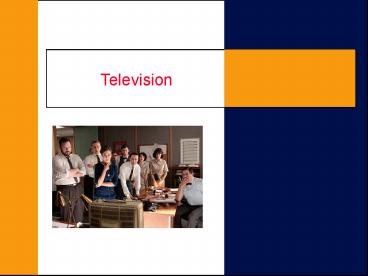Television - PowerPoint PPT Presentation
1 / 22
Title:
Television
Description:
Title: No Slide Title Last modified by: Jim Kearney Created Date: 7/14/1998 6:04:32 PM Document presentation format: On-screen Show (4:3) Other titles – PowerPoint PPT presentation
Number of Views:97
Avg rating:3.0/5.0
Title: Television
1
Television
2
History
- 1939 RCA demonstrates a TV broadcast at the New
York World's Fair features 5-inch bw sets in
stores - FCC halted TV's development during WWII
- 1946 TV in 8,000 homes
- 1956 TV in 35 million homes
- 1960 over 90 of U.S. homes have TV
- 1971 48 of homes have color television
3
Early Television
Shows modeled on radio
Networks CBS, NBC, ABC, DuMont
No UHF dial required on early televisions
4
1950s Content
Golden Age of Live Dramas Texaco Star Theater
starring Mr. Television Milton Berle spurred
TV set sales
5
Organization of U.S. Broadcast TV Industry
- Stations licensed in over 200 markets
- Commercial stations network owned, network
affiliates, or independents - National and local advertising support
6
Today, broadcast stations are spread across 215
U.S. television markets
- 1200 commercial stations
- 365 non-commercial stations
- New digital TV stations can multicast on more
than one channel (10-1, 10-2, 10-3 etc.)
7
Content 1960s
Kennedy-Nixon debates assassination coverage
Bonanza ushers in color
Public Broadcasting Act of 1967 leads to PBS
8
Content the 1970s
Videotaped comedy All in the Family, Sanford
Son, etc
Miniseries events led by Roots capture record
audiences
9
Technology the 1970s
HBO and WTBS distributed by satellite to local
cable operators
Over 90 of viewing still controlled by the ABC,
CBS, NBC
10
1980s and 1990s Increased Competition
1980s Deregulation, more independent
stations, leading to a 4th network Fox
1980s - 1990sCables growing channel capacity
leads to audience fragmentation
11
1980-2000 Cable Satellite Growth
- New narrowcast niche channels boost audience
for non-fiction, sports, and news - Premium channel originals
- Cable packages broadband and telephonewith
video
12
Cable grew with multichannel video, but now has
millions of high speed internet subscribers
13
TV Content important trends
Fox targets younger viewersNBCs must see TV
Thursday night series
1980s
Decade of quality prime-time dramas and comedy on
broadcast networks
1990s
Original cable dramaswin creative
recognitionReality shows
2000s
14
Technology changes how we watch
- Remote control ?active grazing replaced
passive inertia - Mobile remote networking ? video everywhere,
anytime - STBs and DVRs ?time-shifting, storage,interactiv
ity, yet more channels
15
TV Industry Production
Network Primetime Programming
Networks commission and license show from
production companies (often major studios) News
divisions supply newsmagazines Independents
produce some programs, e.g. reality programs
16
TV Industry Production
Broadcast Station Programming
Produce local news Affiliates carry network
programming Buy some programs from syndicators
including reruns and some original programs
17
TV Industry Production
Cable/Satellite/Digital Network Programming
Some programs begin with low budgets until they
become hits Scripted programs often come from
experienced producers with track
records Regional sports networks pay high rights
fees
18
TV Industry International Programming
International sales can offset budget shortfalls
from network license fees International
co-productions can cut, or share expenses Some
top shows are based on foreign programs Public TV
often acquires programs from abroad
19
Major Broadcast Networks (corporate parent
companies/ CEOs)
- ABC The Walt Disney Company
- CBS CBS Corp.
- NBC (NBC/Universal, part of Comcast)
- Fox 21st Century Fox
Bob Iger
Les Moonves
Steve Burke
Rupert Murdoch
20
Public Television
Inadequate funding Organizational problems
Multiple mandates, purposesLimited bottom line
incentives
Challenges
Some local, some PBS, some from abroad, scheduled
locally
Programming
Federal and state governments Viewer
contributions Underwriters, non-profits
Funding
21
The immediate future of television
- When and how will Google compete with the TV
industry as we know it today? - What would happen if the government repealed
retransmission consent rules? - Will new production economics and make very low
budget scripted originals viable?
22
Questions for Discussion
As electronic sell-through replace hard media in
home video, how will the revenue model for
subscription channels evolve?
Is the audiences recent appetite for reality
shows permanent?
How will technology change the way advertisers
use television?
Has TVs daily, accurate measurement of audiences
made its content better?
Are permissive program standards and practices
ever reversible?































